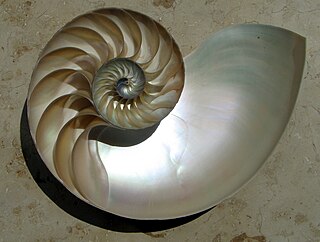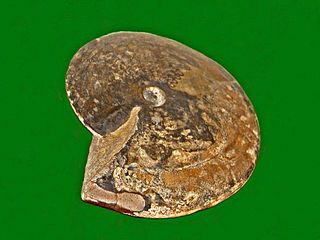
Ammonoids are an extinct group of marine mollusc animals in the subclass Ammonoidea of the class Cephalopoda. These molluscs, commonly referred to as ammonites, are more closely related to living coleoids than they are to shelled nautiloids such as the living Nautilus species. The earliest ammonites appear during the Devonian, and the last species died out in the Cretaceous–Paleogene extinction event.

Goniatids, informally Goniatites, are ammonoid cephalopods that form the order Goniatitida, derived from the more primitive Agoniatitida during the Middle Devonian some 390 million years ago. Goniatites (goniatitida) survived the Late Devonian extinction to flourish during the Carboniferous and Permian only to become extinct at the end of the Permian some 139 million years later.

Nautiloids are a large and diverse group of marine cephalopods (Mollusca) belonging to the subclass Nautiloidea that began in the Late Cambrian and are represented today by the living Nautilus and Allonautilus. Nautiloids flourished during the early Paleozoic era, where they constituted the main predatory animals, and developed an extraordinary diversity of shell shapes and forms. Some 2,500 species of fossil nautiloids are known, but only a handful of species survive to the present day.

Septa are thin walls or partitions between the internal chambers (camerae) of the shell of a cephalopod, namely nautiloids or ammonoids.
In the geologic timescale, the Callovian is an age and stage in the Middle Jurassic, lasting between 166.1 ± 4.0 Ma and 163.5 ± 4.0 Ma. It is the last stage of the Middle Jurassic, following the Bathonian and preceding the Oxfordian.
The Serpukhovian is in the ICS geologic timescale the uppermost stage or youngest age of the Mississippian, the lower subsystem of the Carboniferous. The Serpukhovian age lasted from 330.9 Ma to 323.2 Ma. It is preceded by the Visean and is followed by the Bashkirian.

Stenopterygius is an extinct genus of thunnosaur ichthyosaur known from Europe. This genus of ichthyosaur grew to a maximum length of 4 meters.
The Emsian is one of three faunal stages in the Early Devonian epoch. It lasted from 407 ± 2.8 million years ago to 397.5 ± 2.7 million years ago. It was preceded by the Pragian stage and followed by the Eifelian stage.
The Pragian is one of three faunal stages in the Early Devonian epoch. It lasted from 411.2 ± 2.8 million years ago to 407 ± 2.8 million years ago. It was preceded by the Lochkovian stage and followed by the Emsian stage. The most important lagerstätte of the Pragian is Rhynie chert in Scotland.

Goniatitina is one of two suborders included in the order Goniatitida; extinct Paleozoic ammonoid cephalopods only distantly related to the Nautiloidea.
Medlicottiidae is a family of ammonoid cephalopods belonging to the Prolecanitida, known from the Upper Carboniferous (Pennsylvanian) to the Early Triassic.
Neoaganides is a small, 1–2 cm diameter subdiscoidal to subglobular goniatitid belonging to the family Pseudohaloritidae that lived from the Late Pennsylvanian to the Late Permian, existing for some 56 million years.
Shouchangoceras is a genus of goniatitid pseudohaloritid ammonoids and is the type genus for the pseudohaloritid subfamily Shouchangocerinae. The genus is characterized by a compressed shell as much as 5 cm in diameter, with a strongly constricted mature peristome that has shallow dorsolateral sinus, a moderately deep rounded ventral sinus, but without conspicuous lappets, and ornamented by moderately strong transverse ribs and numerous stronger longitudinal lirae, producing a weakly reticulate pattern. Lobes are attenuate. The siphuncle is within the dorsal septal flecture.
Hauffiopteryx is an extinct genus of ichthyosaur known from Germany, Luxembourg and Somerset of the United Kingdom.
Inyoites is an ammonoid genus from the Lower Triassic, included in the ceratitid family Inyoitidae.

Cephalopod egg fossils are the fossilized remains of eggs laid by cephalopods. The fossil record of cephalopod eggs is scant since their soft, gelatinous eggs decompose quickly and have little chance to fossilize. Eggs laid by ammonoids are the best known and only a few putative examples of these have been discovered. The best preserved of these were discovered in the Jurassic Kimmeridge Clay of England. Currently no belemnoid egg fossils have ever been discovered although this may be because scientists have not properly searched for them rather than an actual absence from the fossil record.

Hedenstroemia is an extinct genus of cephalopods in the ammonoid order Ceratitida. They were nektonic carnivores.
Flemingites is a genus of evolute ammonoids from the Lower Triassic with spiral ridges on the shell.
Meekoceras is a genus of ceratitid ammonites with a discoidal shell that lived during the Early Triassic Period.
Sturia is a genus of ceratitid ammonoids from the Lower Triassic with an ammonitic suture.









